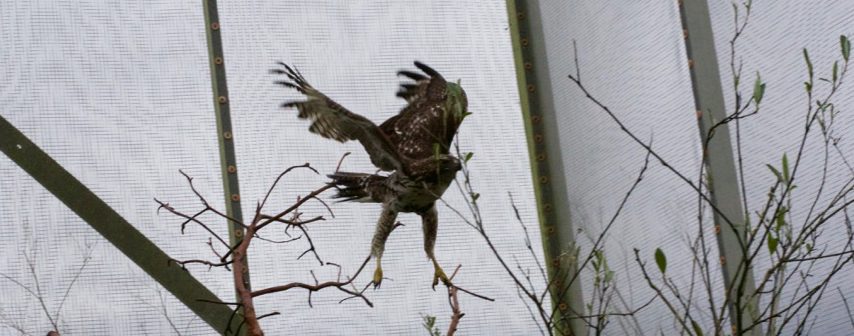
Goin’ home to Ferndale, I’m healthy and I fly
Goin’ home to Ferndale, I’m healthy and I fly
If you ever want to find me, I’ll be in the sky…
The property owners in Ferndale had seen the young Red-tailed Hawk (Buteo jamaicensis) for a few days. They thought something was the matter with him. He’d been hanging out by the side of the road, often on the ground. Each time they approached he would fly up onto a fence post or tree branch. Then, a few Fridays ago, they called Humboldt Wildlife Care Center. He was on the ground not flying at all and they were sure he needed our help.
[Speaking of needing help – we need yours! Our work is funded by your generous support. Our March goal of $7000 has not yet been reached! We still need nearly $1000 – please help us it! You can donate right here. Thank you!]
Clinic staff drove to Ferndale and easily scooped up the ailing hawk. In the exam room, we found a very skinny bird, with a few lacerations ranging in seriousness, but all easily treated. The wounds were old, with some necrotic tissue, and emacation doesn’t happen overnight, so it’s hard to say what came first – his failure to provide himself with dinner, or his injuries. Nothing else appeared to be the matter.
 The young hawk’s admission exam – alert but weak, none of his ailments were life-threatening by themselves, but compounded they had him on the brink of death. (photo: BAX/Gisele Albertine)
The young hawk’s admission exam – alert but weak, none of his ailments were life-threatening by themselves, but compounded they had him on the brink of death. (photo: BAX/Gisele Albertine)
After cleaning and dressing his wounds, the hawk was put on a course of anti-biotics. With emaciated patients, their digestive system can be so compromised that they need a special liquid diet, not unlike a protein shake, before they can eat their natural food. We determine what to offer for food based on many things. An important factor is found in basic blood work, percentage of red blood cells and total dissolved protein. His blood work was actually pretty good – good enough that we could offer whole food immediately, which he immediately devoured.
After a few days of good food and quiet recovery, his wounds were healing and he was strong enough to be housed outdoors. Here he steadily regained strength and gained weight in an impressive display appetite and vigor.
Still, his reluctance to fly, although he had no injuries that would prevent flight, let us know that his strength and stamina were still low.
 Our aviary faces a grazing pasture that rarely has people in it – just cattle. Our patients enjoy a quiet, safe place that is still connected to the outside world. Stress reduction is a key part of our treatment plans for all patients.
Our aviary faces a grazing pasture that rarely has people in it – just cattle. Our patients enjoy a quiet, safe place that is still connected to the outside world. Stress reduction is a key part of our treatment plans for all patients.
 In the aviary, not really flying yet – when we would go in to get him for a check up he would flee from us on foot…
In the aviary, not really flying yet – when we would go in to get him for a check up he would flee from us on foot…
For the first week outdoors he did little more than hop when provoked. He was an impressive hopper, but hopping is not flying. It may seem obvious, but flying is when you stay up in the air on your own power. Most mammals, such as ourselves, have no personal experience of this.
It can be disheartening, tracking a patient’s progress when they simply don’t start to fly. When you watch a bird leave a perch, if all they do is glide to the ground, that’s not flight. Some species of squirrel can do that. Our responsibility to our patient prevents us from wishfully seeing flight where there is none.
However, just as his wounds had quickly healed, and his appetite had returned, and his weight climbed back to normal (from 600 grams to 1100!), when he began flying again, he did so with gusto!
 This is flight!
This is flight!
 After recovery and conditioning, he passed his release evaluation with flying colors!
After recovery and conditioning, he passed his release evaluation with flying colors!
 Back to Ferndale – home again… Ferndale rats beware!
Back to Ferndale – home again… Ferndale rats beware!


 And here we left him, back where he belongs.
And here we left him, back where he belongs.
This Hawk, a youngster, most likely about a year old, was different than every other patient – his recovery was his own, he has his own story. Yet he’s also the same as every other patient – from the common wounds and illnesses that we frequently see and treat, to his needs as a wild animal who requires freedom as much as he requires protein. His rehabilitation wasn’t by the numbers, nor was it really very different from any others’. He is unique and ordinary – like each of us – and his care mattered the world to him. There is one more hawk still in this sweet old world, thanks to the people who watched him and knew that he was in trouble, to the advice they got to call us, and to your support that keeps our doors open and our aviaries ready. Thank you for helping us help this Hawk.
[Want to help? Donate here. Thank you!]

All photos: Bird Ally X/ Laura Corsiglia, except where otherwise noted.

